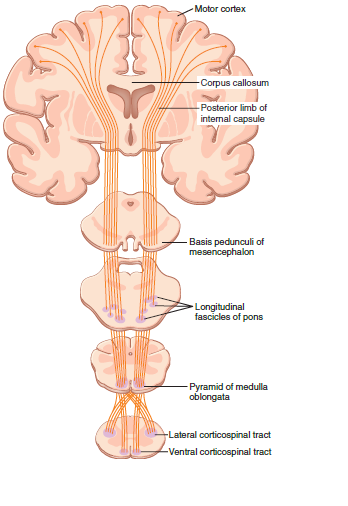
Cortical and Brain Stem Control of Motor Function
Most “voluntary” movements initiated by the cerebral cortex are achieved when the cortex activates “patterns” of function stored in lower brain areas—the cord, brain stem, basal ganglia, and cerebellum. These lower centers, in turn, send specific control signals to the muscles. For a few types of movements, however, the cortex has almost a direct pathway to the anterior motor neurons of the cord, bypassing some motor centers on the way. This is especially true for control of the fine dexterous movements of the fingers and hands. This lesson explain the interplay among the different motor areas of the brain and spinal cord to provide overall synthesis of voluntary motor function.
Think about the neural systems called into play, for example, during the simple act of picking up an apple to eat. Your memory tells you the fruit is in a bowl on the kitchen counter. Sensory systems, coupled with your knowledge based on past experience, enable you to distinguish the apple from the other kinds of fruit in the bowl. On receiving this integrated sensory information, motor systems issue commands to the exact muscles of the body in the proper sequence to enable you to move to the fruit bowl and pick up the targeted apple. During execution of this act, minor adjustments in the motor command are made as needed, based on continual updating provided by sensory input about the position of your body relative to the goal. Then there is the issue of motivation and behavior. Are you reaching for the apple because you are hungry (detected by a neural system in the hypothalamus) or because of a more complex behavioral scenario (for example, you started to think about food because you just saw someone eating on television)? Why did you choose an apple rather than a banana when both are in the fruit bowl and you like the taste of both, and so on? Thus, initiating and executing purposeful voluntary movement actually include a complex neuronal interplay that involves output from the motor regions guided by integrated sensory information and ultimately depends on motivational systems and elaboration of thought. All this plays against a background of memory stores from which you can make meaningful decisions about desirable movements
At the end of the lesson students will be able to learn;
- General organization of the nervous system
- The production, circulation, absorption and functions of CSF
- The blood brain and blood CSF barriers and their clinical significance
- The functions of the cerebral cortex
- Differentiate between the sensory and motor cortex and their functions
- The motor pathways including pyramidal and extrapyramidal
- The functions of vestibular apparatus
- The organization and functions of reticular formation.
- The control of posture and equilibrium


